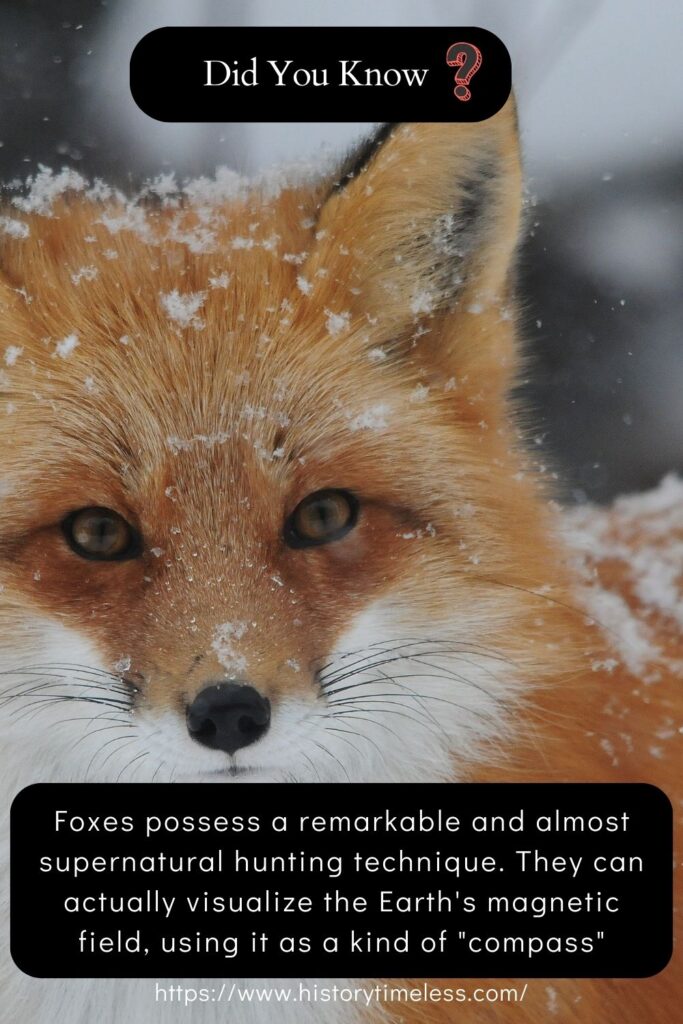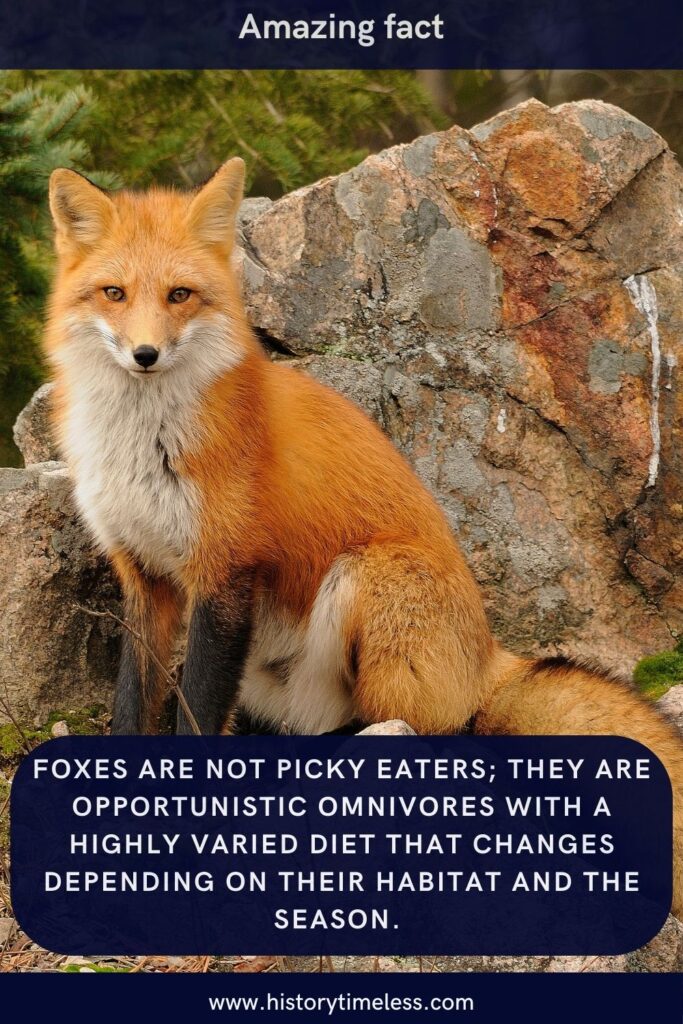Foxes are captivating creatures that roam diverse landscapes across the globe, from bustling cities to serene forests. Belonging to the Canidae family, they share kinship with wolves and dogs, yet possess a unique charm and adaptability all their own.
Renowned for their intelligence, agility, and striking appearance, foxes have woven their way into folklore and popular culture for centuries.
But beyond their cunning reputation, there’s a wealth of surprising and endearing truths about these resourceful animals.
Prepare to uncover 25 intriguing facts that will illuminate the secret lives of foxes and deepen your appreciation for their vital role in the natural world.
1. Foxes Use Earth’s Magnetic Field to Hunt with Precision
Foxes possess a remarkable and almost supernatural hunting technique. They can actually visualize the Earth’s magnetic field, using it as a kind of “compass” to pinpoint the location of prey hidden beneath snow or dense vegetation.

This incredible ability, known as magnetoreception, allows them to leap with astonishing accuracy, often landing directly on top of their unsuspecting meal.
Imagine having an invisible map guiding you to your next snack – that’s the sensory superpower foxes wield in their daily hunt for survival! This makes them incredibly efficient predators, especially in environments where prey is concealed.
2. Foxes are Masters of Whisker-Based Navigation in the Dark
While their large, forward-facing eyes provide excellent binocular vision, foxes also heavily rely on their sensitive whiskers, or vibrissae, for navigating their surroundings, especially in low-light conditions or complete darkness.
These specialized hairs are not just for show; they are packed with nerve endings that detect even the slightest changes in air currents and textures.
Imagine whiskers as an extension of their senses, helping them “feel” their way through dense undergrowth, assess the size of burrows, and even detect the movement of prey nearby, all without needing to see clearly. This whisker-powered perception is crucial for their nocturnal activities.
3. Foxes Exhibit a Wide Range of Vocalizations Beyond Just “Barking”
While the characteristic fox bark is well-known, these animals have a surprisingly diverse vocal repertoire, using at least 40 different sounds to communicate. These range from playful yelps and chatters to piercing screams and guttural growls.
Each vocalization conveys specific messages, whether it’s to attract a mate, warn off rivals, or communicate with their kits.
Listen closely in fox habitats, and you might be surprised by the complex “conversations” unfolding, revealing a sophisticated social structure and communication system far beyond simple barks. They truly have a language all their own!
4. Foxes Are Found on Almost Every Continent Across the Globe
Foxes are incredibly adaptable animals, thriving in a vast array of habitats spanning nearly every continent on Earth, excluding Antarctica. From the scorching deserts of North Africa to the icy tundra of the Arctic, and even within bustling urban environments, foxes have proven their resilience.
This global distribution highlights their remarkable ability to adjust to diverse climates, food sources, and landscapes.
Whether it’s the red fox in Europe, the fennec fox in the Sahara, or the gray fox in North America, these canids have carved out niches in almost every corner of the world.
5. Foxes Are Solitary Hunters but Form Strong Family Bonds
Despite often being portrayed as solitary creatures, foxes, particularly red foxes, exhibit surprisingly strong family bonds. While they typically hunt and forage alone, during the breeding season and while raising their young, they form close-knit family units.
The vixen (female fox) and dog fox (male fox) often mate for life and cooperate in raising their kits. Sometimes, even older offspring from previous litters may stay to help care for younger siblings, demonstrating a level of cooperative parenting and social complexity not always associated with solitary animals.
6. Fox Kits Are Born Deaf, Blind, and Entirely Dependent
Fox kits, or baby foxes, are born into the world in a very vulnerable state. For the first few weeks of their lives, they are completely reliant on their mother, as they are born deaf, blind, and unable to regulate their own body temperature.
The vixen diligently cares for her helpless offspring in the den, providing warmth, nourishment, and constant protection.
This period of intense maternal care is crucial for the kits’ survival and development, highlighting the dedication of fox mothers in ensuring the next generation thrives.
7. Foxes Engage in Playful Behavior, Even as Adults
Foxes are known for their playful nature, and this isn’t limited to just young kits. Adult foxes often engage in playful activities such as chasing their tails, pouncing on imaginary prey, and even playing with objects like sticks or pine cones.
This playful behavior serves several purposes, including honing their hunting skills, strengthening social bonds, and simply providing mental stimulation.
Observing foxes at play offers a glimpse into their intelligent and curious minds, showcasing that even in the wild, animals find joy and enrichment in simple games.
8. Foxes Have Developed Unique Adaptations to Urban Environments
In recent decades, foxes have increasingly adapted to living in urban and suburban environments. These “city foxes” demonstrate remarkable adaptability, learning to navigate busy streets, find food in gardens and bins, and even den under sheds or in parks.
They have become accustomed to human presence and can sometimes be seen patrolling neighborhoods.
This urban adaptation highlights their intelligence and flexibility, but also raises questions about human-wildlife coexistence and the challenges of managing wildlife populations in urban landscapes.
9. Foxes Employ a “Pounce” Technique for Catching Small Prey
The iconic “fox pounce” is a highly specialized hunting technique, particularly effective for catching small rodents hidden in tall grass or under snow. Foxes will freeze, listen intently, and then leap high into the air, landing with pinpoint accuracy on top of their prey.
This dramatic pounce utilizes their excellent hearing and spatial awareness, honed over generations of hunting. It’s a captivating display of predatory skill and agility, showcasing their mastery of hunting small, elusive creatures.
10. Foxes Can Run Up to 30 Miles Per Hour When Necessary
While not built for sustained long-distance running like wolves, foxes are surprisingly fast sprinters when they need to be. They can reach speeds of up to 30 miles per hour in short bursts, which is essential for escaping predators or chasing down swift prey like rabbits or hares.
This speed, combined with their agility and maneuverability, makes them formidable hunters and allows them to navigate diverse terrains with ease. Their bursts of speed are a vital tool in their survival toolkit.
11. A Group of Foxes is Called a “Skulk” or a “Leash”
Just like other animals have collective nouns (a flock of birds, a herd of cows), a group of foxes is referred to as either a “skulk” or a “leash.”
The term “skulk” perhaps reflects their often secretive and elusive nature, while “leash” might allude to the idea of a group being loosely connected or following each other.
While foxes are often solitary, during mating season or when raising young, you might occasionally observe small groups, or skulks, of foxes interacting, especially kits playing together.
12. Foxes Have Excellent Hearing, Able to Hear Low Frequencies
Foxes possess exceptionally acute hearing, far surpassing that of humans and even many domestic dogs. They can detect low-frequency sounds from great distances, allowing them to locate prey moving underground or hidden in dense cover.
Their large, pointed ears are not just for show; they act like sensitive antennae, funneling sound waves and enabling them to pinpoint the precise location of a rustling vole or scurrying mouse. This incredible auditory ability is a cornerstone of their hunting prowess.
13. Foxes Use Their Bushy Tails for Balance and Communication
The bushy tail of a fox is more than just a decorative feature; it serves several important functions. Primarily, it acts as a counterbalance, aiding in agility and stability, especially when running and making sharp turns.
In cold weather, the tail can be wrapped around their body for warmth, acting like a furry blanket. Additionally, foxes use their tails for communication, signaling their mood and intentions through different tail positions and movements. A wagging tail, for instance, can indicate excitement or playfulness.
14. Foxes Are Opportunistic Eaters with a Diverse Diet
Foxes are not picky eaters; they are opportunistic omnivores with a highly varied diet that changes depending on their habitat and the season.

While they are primarily carnivores, feasting on rodents, rabbits, birds, and insects, they also readily consume fruits, berries, eggs, and even scavenge for carrion.
This dietary flexibility is a key factor in their adaptability and success in diverse environments. From urban scraps to wild berries, foxes are resourceful foragers, taking advantage of whatever food sources are available.
15. Red Foxes Can Have Different Color Variations Beyond Red
While the iconic red fox is indeed reddish-brown, red foxes exhibit a surprising range of color variations. These variations, known as morphs, include silver foxes (black with silver-tipped fur), cross foxes (reddish-brown with a dark cross pattern on their shoulders), and even melanistic foxes (completely black).
These color variations are genetically determined and can occur in the same litter, showcasing the genetic diversity within red fox populations. It’s a reminder that “red fox” is a species, not necessarily a singular color.
16. Foxes Bury Food Caches to Save for Later
Foxes are intelligent hoarders, frequently burying surplus food in caches to eat later when food might be scarce. This behavior, known as caching, is a survival strategy that ensures they have access to food even during lean times.
They might bury rodents, eggs, or other food items in shallow holes, often marking the spot with scent. Their excellent memory and sense of smell help them relocate these hidden treasures, demonstrating their foresight and planning abilities.
17. Fox Dens Can Be Elaborate Underground Burrows
Foxes typically den in underground burrows, which can range from simple holes to elaborate tunnel systems with multiple entrances and chambers.
They may dig their own dens, but often they will enlarge and modify existing burrows created by other animals like rabbits or badgers.
These dens provide shelter from weather, protection from predators, and a safe place to raise their young. Den locations are often chosen strategically, offering good vantage points and proximity to food sources.
18. Foxes Play Important Roles in Controlling Rodent Populations
As efficient predators of rodents, foxes play a crucial role in maintaining ecological balance by controlling populations of mice, voles, and other small mammals.
This helps to prevent overgrazing, protect crops, and reduce the spread of rodent-borne diseases. In ecosystems where foxes are present, they act as natural pest control agents, contributing to the health and stability of the environment. Their predatory role is vital for ecosystem function.
19. Foxes Have Vertical Pupils Like Cats, Aiding Night Vision
Unlike dogs, which have round pupils, foxes possess vertical pupils, similar to cats. This adaptation is beneficial for nocturnal animals, as vertical pupils allow for greater control over light entering the eye.
They can constrict tightly in bright daylight to reduce glare and dilate widely in low light to maximize light gathering, enhancing their night vision. This specialized eye structure is a key adaptation for their crepuscular and nocturnal hunting habits.
20. Fox Scent Glands Produce a Musky Odor for Marking Territory
Foxes possess scent glands located near their tails that produce a musky odor. They use this scent to mark their territory, communicating with other foxes.
Scent marking is crucial for establishing boundaries, signaling reproductive status, and conveying information within fox populations.
This chemical communication is a vital part of their social interactions and spatial organization within their territories.
21. Foxes Can Learn to Recognize Individual Humans
While generally wary of humans, foxes that live in close proximity to people, especially in urban areas, can learn to recognize individual humans.
This is not to say they become domesticated pets, but they can learn to associate certain people with safety or even the provision of food (though feeding wild foxes is generally discouraged).
This recognition demonstrates their intelligence and ability to learn and adapt to their specific environment, including the human element within it.
22. Foxes are Subject to Diseases Like Rabies, But Also Mange
Like many wild animals, foxes are susceptible to certain diseases. Rabies is a serious viral disease that can affect foxes, although vaccination programs have helped to control its spread in some regions.
Another common disease is mange, a skin condition caused by mites, which can cause fur loss and skin irritation. Understanding these health challenges is important for wildlife management and conservation efforts.
23. Foxes Are Often Featured in Folklore and Mythology Worldwide
Foxes have held a prominent place in folklore and mythology across cultures around the world for centuries. Often portrayed as cunning tricksters, intelligent strategists, or symbols of wisdom and adaptability, they appear in countless stories, myths, and legends.
From the Japanese kitsune to the European Reynard the Fox, these tales reflect both admiration and caution towards these enigmatic animals, highlighting their enduring impact on human imagination.
24. Fox Conservation Status Varies Depending on Species and Region
The conservation status of foxes varies significantly depending on the specific species and geographic region. While some fox species, like the red fox, are widespread and abundant, others, such as the island fox in California, are endangered and require specific conservation efforts.
Habitat loss, hunting, and disease are among the threats facing different fox populations globally. Conservation initiatives are crucial to ensuring the long-term survival of vulnerable fox species.
25. Watching Foxes in the Wild Can Be a Rewarding Experience
Observing foxes in their natural habitat can be an incredibly rewarding and enriching experience for wildlife enthusiasts.
Whether it’s witnessing their graceful movements, playful interactions, or skilled hunting techniques, encountering a fox in the wild offers a glimpse into the fascinating world of these intelligent and adaptable creatures.
Responsible wildlife watching, from a respectful distance, allows us to appreciate their beauty and behavior without disturbing their natural lives.
Discover more intriguing insights:
26 Weird Facts About Fruit You’ll Want to Tell Everyone!
25 Facts About Flower That’ll Make You See Them Differently!
20+ Insane Facts About Animals That Defy Belief!
15+ Interesting World Facts: Say ‘Wow’ to These Discoveries!





